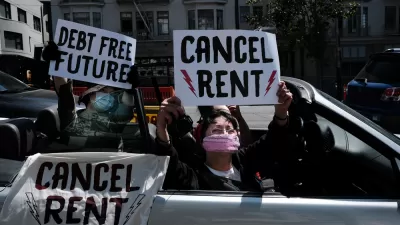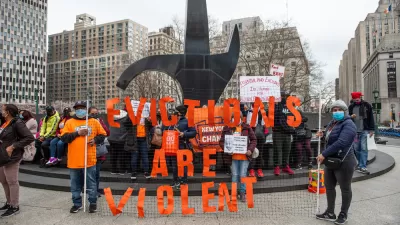While some cities and states have prohibited all construction during the first few months of the pandemic, other locations are leaning on construction projects as a source of employment and improvements during tough times.

With more than 3 million cases of the COVID-19 coronavirus worldwide, the economic effects of the pandemic are also now apparent far beyond the stock market. Unemployment statistics indicate that more than 26 million people are out of work in the United States alone, and many entire industries—such as tourism and restaurants—are at a near standstill due to widespread lockdowns and restrictions.
Analysts vary dramatically in their opinions about how long it may take for economic recovery to happen, and what to do to facilitate it. Some participants at a recent University of California, Berkeley panel asserted that an economic recovery could not happen without a focus on public health. Others said it's crucial to prioritize workers and people of color.
Those are crucial areas to consider moving forward, but some leaders are also realizing that getting the economy back on track must occur at a local level. In March, Colorado Springs announced assistance that included a $4 million COVID-19 relief fund for small businesses, including microloans and tax forgiveness. Here are some other thought-provoking ways local projects could spur COVID-19 relief efforts.
Reduced Traffic Could Accelerate Transit Improvement Projects
Experts in the United Kingdom and elsewhere explained how less traffic on the roads due to global lockdowns improved air quality. They pointed out that this brief period of clean air has given the public a glimpse of the potential benefits of infrastructure projects and other investments designed to cut pollution. They also discussed how breathing cleaner air helps everyone—especially those with chronic conditions.
Some cities are taking advantage of the lower traffic levels to push ahead with their public transit improvements. In Beverly Hills, city officials voted to close a three-block section of a boulevard for several months to work on a subway extension. The city believes this decision will save up to six months of building time. The broader outcome may be that people are more eager and willing to use public transit once the economy restarts—particularly in high-traffic areas such as the Los Angeles region. As people return to shopping, dining out, and working while using public transportation, the economy may begin recovering.
Experts have also mentioned that demographics are a primary driver of public transit ridership. With low-income groups among the hardest hit, questions remain about whether they will become even more dependent on local transportation options to keep costs down. Adequate routes and service levels might be hard to find in the post-COVID-19 world.
Local Projects Could Help Local Construction Firms Stay Afloat
Decisions at the local level determine whether a construction company is an essential business during COVID-19—with some variations present within individual states. Even when firms get operating permission, they face social distancing restrictions. Some site managers are already using connected, wearable sensors to remind crew members to stay far enough apart.
A construction company called JE Dunn introduced new safety measures for large projects. They include working and breaking in shifts to minimize crowding, as well as installing more hand-washing stations. Construction workers often wear goggles and gloves, both of which could stop the spread of COVID-19 while boosting workplace safety.
Local construction firms must thoroughly research to determine if and how they can stay open. Some infrastructure projects could stimulate the economy when things return to relative normalcy. Financially struggling companies should investigate a variety of options, such as investing in used equipment instead of buying new to resume operations.
City governments have launched new initiatives for small businesses, too. In Charlottesville, Virginia, help includes microgrants to alleviate fixed cost burdens, plus actions to promote employee retention and rehiring. Some construction companies might use similar financial support to move ahead with infrastructural projects previously halted in part due to cost concerns.
Also, in Edmonton, Canada, city officials want to invest more than $2 billion in a stimulus package to create at least 10,500 construction jobs this summer. The focal points are on infrastructure projects related to recreation centers, road improvements and flood mitigation strategies.
Existing Resources Could Speed Urban Economic Recoveries
Some community living situations make the effects of the coronavirus more prevalent. For example, overcrowded housing means it's difficult or impossible to maintain social distance. Moreover, if people cannot access local health care clinics and the closest options are too far away, they likely won't get prompt diagnoses of COVID-19 or other ailments that could spread to others.
Conversely, cities can lead the way to start and maintain local economic recovery. For example, neighborhood organizations are helping with homelessness outreach and small-business support. Community coalitions link people with child care and suggest how consumers can support enterprises during these times of abnormal operations, too.
It's unclear whether these current efforts might continue after the coronavirus crisis eases. If they do, the result could be a new era where people are aware of and use community resources that were unavailable before COVID-19 struck.
Proactive Local Action Could Make Meaningful Gains
Discussions about economic depressions dominate the headlines and talk shows. These are valid conversations, but people must not stay stuck in doom-filled mindsets. They must start to find ways forward towards gradual, noticeable economic recovery. As they do so, infrastructure projects happening at the local level should not be overlooked
News about national stimulus packages captures public attention, and federal efforts could pay off during these unprecedented circumstances, too. However, if people see investments in infrastructure strengthening their communities, rather than faltering under the strain, they're more likely to believe in a path out of the economic crisis.

Planetizen Federal Action Tracker
A weekly monitor of how Trump’s orders and actions are impacting planners and planning in America.

Maui's Vacation Rental Debate Turns Ugly
Verbal attacks, misinformation campaigns and fistfights plague a high-stakes debate to convert thousands of vacation rentals into long-term housing.

San Francisco Suspends Traffic Calming Amidst Record Deaths
Citing “a challenging fiscal landscape,” the city will cease the program on the heels of 42 traffic deaths, including 24 pedestrians.

Amtrak Rolls Out New Orleans to Alabama “Mardi Gras” Train
The new service will operate morning and evening departures between Mobile and New Orleans.

The Subversive Car-Free Guide to Trump's Great American Road Trip
Car-free ways to access Chicagoland’s best tourist attractions.

San Antonio and Austin are Fusing Into one Massive Megaregion
The region spanning the two central Texas cities is growing fast, posing challenges for local infrastructure and water supplies.
Urban Design for Planners 1: Software Tools
This six-course series explores essential urban design concepts using open source software and equips planners with the tools they need to participate fully in the urban design process.
Planning for Universal Design
Learn the tools for implementing Universal Design in planning regulations.
Heyer Gruel & Associates PA
JM Goldson LLC
Custer County Colorado
City of Camden Redevelopment Agency
City of Astoria
Transportation Research & Education Center (TREC) at Portland State University
Jefferson Parish Government
Camden Redevelopment Agency
City of Claremont






























